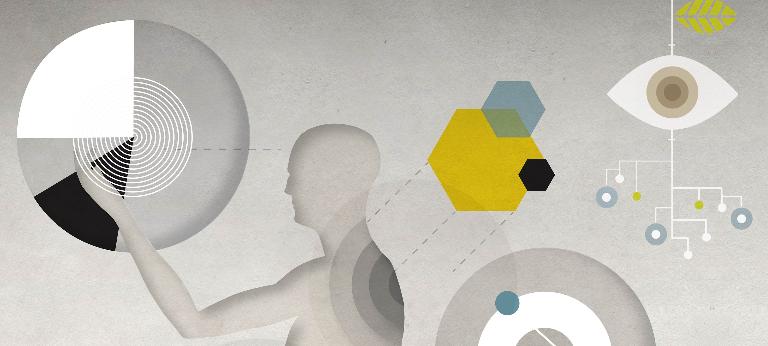AI think, therefore AI am
![{[downloads[language].preview]}](https://www.rolandberger.com/publications/publication_image/think_act_magazines_artificial_intelligence_roland_berger_cover_download_preview.jpg)
What exactly do people mean when they talk about AI in 2018? Where do I start if I want to embrace AI in my business? Get your questions answered in our Think:Act magazine on artificial intelligence.


by Nicola Davison
illustrations by Chad Hagen
For the doomsayers, "AI-augmented workplace" might as well be code for "impending mass unemployment." Yet many believe that giving repetitive tasks to smart machines will free us to reimagine our working roles as human beings. There's nothing to fear. But it is time to prepare.
When a child comes to her clinic for the first time, Sofia Douzgou asks the parents if she can take their picture. Douzgou, a consultant geneticist who specializes in the diagnosis of rare disorders at the Manchester Centre for Genomic Medicine, then uploads the photo to an app called Face2Gene, along with additional information about the patient and observations from the clinic. The app utilizes facial recognition software to convert the image to data, which is uploaded to a cloud and crunched against a database. Douzgou then receives a "best syndrome match" within seconds.
The diagnosis of rare disorders is a difficult business. Scientists have so far identified 7,000 inherited genetic conditions that affect about 8% of the world's population; there may be thousands more. Many of these conditions have distinct craniofacial characteristics – Down syndrome is a well-known example. Yet if the clinician has never encountered a certain disorder before, seeing what the machine thinks can be helpful. "In the great majority of times, a rare genetic condition that affects the child may not be evident before birth and can be a complete surprise to the family," says Douzgou. "We need to look for a diagnosis taking into consideration a possible differential of thousands of disorders." Face2Gene, she says, is a useful tool – but its usefulness is limited. "My job is made up of much more than just identifying a similar facial pattern among patients."

Though the idea once belonged to science fiction, in the past couple of years, as the technology has improved, organizations and businesses in diverse sectors have started to experiment with the different ways that intelligent machines can assist humans at work. Executives can now schedule meetings using "Amy Ingram," an AI-powered personal assistant developed by New York-based company x.ai. The Big Four auditors have started using tools that flag anomalies in company accounts. Pfizer recently signed a partnership with IBM in order to speed up drug discovery. The NHS in the UK is trying out a virtual team-building coach called CoachBot.
As the use of AI has become more widespread, many fears about "robots taking over" have proliferated. The fears are not groundless. In 2013, a study by researchers at the University of Oxford found that 47% of jobs in the US are at high risk of being "substituted" by computers. And it is not just the manually laborious tasks that are at risk – many white-collar professionals risk being automated, from accountants, clerks and taxi drivers to cashiers, telemarketers and receptionists.
But not everyone is convinced that the rise of AI will create mass joblessness, as the doomsayers predict. "It's not an irrational concern, in the sense that these machines, smart machines, can do any task that humans can do," says Tom Davenport, a professor at Babson College who specializes in innovation in the technology and management spheres. "But I think people don't often realize that humans at work do a whole variety of tasks typically, and just because you automate one or two of them, jobs don't tend to go away."
In "Only Humans Need Apply: Winners and Losers in the Age of Smart Machines", Davenport and his co-author Julia Kirby argue that the debate should be reframed. Rather than focusing on the threat of automation, we need to seek the opportunities that will arise from "augmented" workplaces – where thinking machines assist us. Machines are good at crunching vast reams of data quickly, picking out patterns from which they can form a hypothesis. It would take a human weeks to compare the data taken from a photo of a child's face to others in a database. Yet it is hard to imagine an AI replicating the capacity for empathy required when a doctor communicates with a patient.
The pioneers of augmentation necessarily belong to sectors or industries that generate a lot of data, such as the law, medicine and agriculture. One French startup, CybeleTech, is using mechanistic modeling, big data and high-performance computing (HPC) to improve customers' agricultural output. Innovations in agriculture are sorely needed, says manager Marie Joseph Lambert, in a world with limited natural resources and a ballooning population. "If you want to increase the production of agriculture in the world with the same way we farm today, it's impossible," he says.
CybeleTech started with seeds. The big seed breeding companies spend millions of dollars each year on R&D in the search for the best new varieties. CybeleTech realized that mechanistic models were good at predicting which seeds would work best in a specific environment. From there, the company began crunching data from individual fields – data about soil type, weather, the heterogeneity of plants and so on – in order to help farmers understand how to get the best possible yield, an approach known as "precision farming."
Lambert says that the company is now looking to expand its presence abroad. He expects annual turnover this year to reach $1.74 million, a year-onyear increase of nearly 50%. The company employs 14 people and Lambert plans to hire five more by the end of the year – a rejoinder to the latent anxiety about AI taking away jobs. History suggests that this is no anomaly. Two centuries ago, during the Industrial Revolution, textile workers known as the Luddites began destroying the machinery that they believed would obliterate their livelihood. But as more of the tasks in the weaving process became automated, workers were able to focus on managerial and operational tasks. This led to a surge in output, which in turn created more jobs. In the US the number of weavers quadrupled between 1830 and 1900. Recent research supports this premise. A 2016 report by Deloitte found that while technology has contributed to the loss of 800,000 lower-skilled jobs in the UK, it has helped to create nearly 3.5 million new, higher-skilled ones in their place.
The Industrial Revolution was different, says machine learning expert Anthony Goldbloom, because it was the mechanical jobs that were under threat in the 1800s. Today, it is any task that is "frequent and high volume." He explains: "Machine learning is only really useful – despite all the buzz and hysteria about it – for things that are very repetitive." Goldbloom is the founder and CEO of Kaggle, a company that hosts competitions where its data scientist community attempts to solve difficult problems using machine learning. In 2012, the community developed an algorithm that was able to grade high school essays that matched the assessment of human teachers. According to Goldbloom, machines will come to outperform humans in any task that requires predictive analysis. But Goldbloom also believes that relinquishing repetitive tasks to machines is no bad thing. "I think things that are repetitive are not the most enriching parts of our work lives," he says.
"I think things that are repetitive are not the most enriching parts of our work lives."
There are many jobs that machines can't do, Goldbloom points out – they are flummoxed by novelty. Machines need vast volumes of data to make predictions, whereas humans are able to connect threads to solve problems not previously encountered. As machines take over in frequent, high-volume work, people will migrate to roles that call for critical thinking, creativity, judgment and common sense, and that extends to the top tiers of management. "I think [AI] will completely change the way people work," says Augustin Huret, founder and CEO of MondoBrain, a company that develops "augmented intelligence" software to help executives to make decisions based on their ability to grasp the drivers and influences on a business. Managers can take this AI intelligence and combine it with their own experience and the "collective intelligence" of their colleagues. "Augmented is the ability of a manager to leverage those three intelligences for every decision on their business for every key performance indicator," Huret says. He believes that rather than being replaced, tomorrow's managers will need to develop a different skill set. "Their role is going to massively change from being good at understanding the drivers to being good at observing the world and observing their business," he says.
Predicting what jobs will be created in the future is difficult – after all, the idea of making a living as a website designer would have seemed strange just 20 years ago. But there are ways to prepare. Davenport advises companies to draw up what he calls an "augmentation strategy." He explains: "Augmented strategies involve looking at every work process and job and saying: 'What's the structured data component that might be better done by a machine, and what are the roles for humans?' There's a lot of 'work design,'" he says. Individuals, meanwhile, need to think realistically about what aspect of their jobs might be carried out by AI, and plan accordingly. We might "step up" to a role that requires high levels of abstraction and critical thinking or "step narrowly" into a specialist career that would not be economical to automate.
In almost all cases, Davenport says, people-jobs will be less codified and structured. And, hopefully more fulfilling. "I think that there's a bright future for people who are willing to change their skills and who are willing to work to either add to the work of smart machines, work alongside them, manage them or to do something that they can't do," he says.

![{[downloads[language].preview]}](https://www.rolandberger.com/publications/publication_image/think_act_magazines_artificial_intelligence_roland_berger_cover_download_preview.jpg)
What exactly do people mean when they talk about AI in 2018? Where do I start if I want to embrace AI in my business? Get your questions answered in our Think:Act magazine on artificial intelligence.
Curious about the contents of our newest Think:Act magazine? Receive your very own copy by signing up now! Subscribe here to receive our Think:Act magazine and the latest news from Roland Berger.
